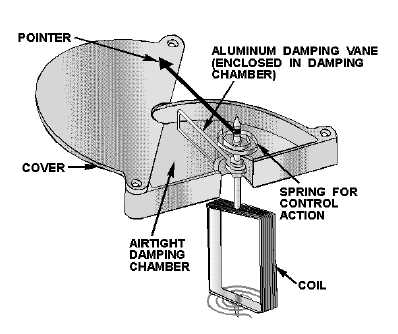1-12
By connecting a rectifier to a d’Arsonval meter movement, an alternating current measuring device is
created.
When ac is converted to pulsating dc, the d’Arsonval movement will react to the average value of the
pulsating dc (which is the average value of one-half of the sine wave). Another characteristic of using a
rectifier concerns the fact that the d’Arsonval meter movement is capable of indicating current in only one
direction. If the d’Arsonval meter movement were used to indicate alternating current without a rectifier,
or direct current of the wrong polarity, the movement would be severely damaged. The pulsating dc is
current in a single direction, and so the d’Arsonval meter movement can be used as long as proper polarity
is observed.
DAMPING
A problem that is created by the use of a rectifier and d’Arsonval meter movement is that the pointer
will vibrate (oscillate) around the average value indication. This oscillation will make the meter difficult
to read.
The process of "smoothing out" the oscillation of the pointer is known as DAMPING. There are two
basic techniques used to damp the pointer of a d’Arsonval meter movement.
The first method of damping comes from the d’Arsonval meter movement itself. In the d’Arsonval
meter movement, current through the coil causes the coil to move in the magnetic field of the permanent
magnet. This movement of the coil (conductor) through a magnetic field causes a current to be induced in
the coil opposite to the current that caused the movement of the coil. This induced current will act to
damp oscillations. In addition to this method of damping, which comes from the movement itself, most
meters use a second method of damping.
The second method of damping used in most meter movements is an airtight chamber containing a
vane (like a windmill vane) attached to the coil (fig.1-14).
Figure 1-14.—A typical meter damping system.



